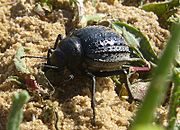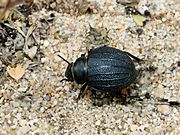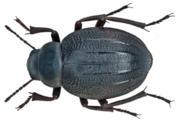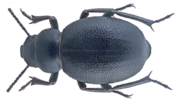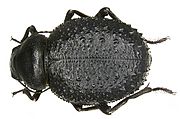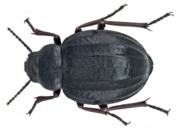Pimelia facts for kids
Quick facts for kids Pimelia |
|
|---|---|
 |
|
| Pimelia obsoleta | |
| Scientific classification |
|
| Kingdom: | Animalia |
| Phylum: | Arthropoda |
| Class: | Insecta |
| Order: | Coleoptera |
| Family: | Tenebrionidae |
| Subfamily: | Pimeliinae |
| Tribe: | Pimeliini |
| Genus: | Pimelia Fabricius, 1775 |
Pimelia is a group of darkling beetles. These beetles are found in many dry places, especially deserts. They are known for their tough bodies. They have special ways to survive in harsh environments.
Contents
Different Kinds of Pimelia Beetles
There are many different kinds, or species, of Pimelia beetles. Scientists have given each one a unique name. Some examples include Pimelia angulata and Pimelia bipunctata. Each species has its own special features.
Life Cycle and Reproduction
Pimelia beetles usually have one generation born each year. This means they are univoltine. In places like North Africa, the adult beetles come out in January. This is when many flowers start to bloom. They begin to mate around this time.
Normally, Pimelia beetles eat dead plants and other decaying matter. They are called detritivores. But during mating season, they might eat other adult beetles, young larvae, or even eggs. This is a type of cannibalism. Scientists think they do this to get extra nutrients. It might also be a way to get rid of rivals.
Mating often happens on the steep side of a sand dune. After mating, the female beetle digs a small hole. She lays a single egg there. The egg looks a lot like a grain of white rice. When the temperature gets very hot (above 50°C), the adult beetles die. The young beetles stay hidden under the sand. They grow there until they are ready to become adults. The new adult beetles then come out during the winter.
How Pimelia Beetles Survive in the Desert
Many Pimelia species are easy to spot as they move across sand dunes. They have special hairs on their legs called setae. These hairs help them move quickly on the loose sand. They can even tumble fast across the dunes.
These beetles have amazing adaptations to live in dry and desert places. These adaptations help them survive and have babies in the dunes. The desert environment is very challenging. It has extreme temperatures, very little water, strong winds, and shifting sand. There are also very few plants.
Pimelia beetles have several body features that help them survive. Their outer skin, called the cuticle, has special layers of fat. These layers stop water from escaping their bodies. Their body plates, called sclerites, are joined together. This also helps prevent water loss. However, it means they cannot fly.
The main way insects keep water inside is through the fatty layer of their cuticle. The temperature can affect how well this works. If it gets too hot, the cuticle might let more water out. This is called the transition temperature.
Pimelia beetles also have small holes called spiracles. These holes are for breathing. But instead of opening directly to the air, they open into a moist space under their wing covers. This space is called the subelytral cavity. This design helps them lose less water. Their tough wing covers, called elytra, also help keep water in. The surface of their elytra has small bumps called tubercles. These bumps help scatter and reflect sunlight. This keeps the beetle cooler.
Digging into the sand is a very important behavior for Pimelia beetles. It helps them control their body temperature. They can find cooler spots under the sand. Pimelia beetles are active during the day, which is called diurnal. They come out in the early morning and late evening. But they stay under the sand during the hottest parts of the day.
Gallery
See also
 In Spanish: Pimelia para niños
In Spanish: Pimelia para niños


